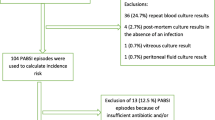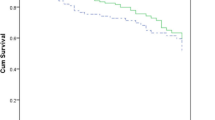Abstract
P. aeruginosa bloodstream infection (BSI) is associated with high hospital mortality. Empirical combination therapy is commonly used, but its benefit remains debated. The purpose of this study was to describe in a paediatric population, demographical characteristics and outcome of children treated for P. aeruginosa BSI receiving either a combined or single antibacterial therapy. We performed a retrospective, single-centre, cohort study of hospitalized children with P. aeruginosa BSI from 2007 to 2015. A total of 118 bloodstream infections (BSI) were analysed (102 (86.4%) hospital-acquired, including 52 (44.1%) hospitalized in intensive care unit). In immunocompromised children, 52% of BSI episodes were recorded. Recent medical history revealed that 68% were hospitalized, 31% underwent surgery and 67% had a prior antibiotic therapy within the last 3 months. In-hospital mortality was similar for patients receiving single or combined anti-Pseudomonas therapy (p = 0.78). In multivariate analysis, independent risk factors for in-hospital mortality were neutropenia (OR = 6.23 [1.94–20.01], hospitalization in ICU (OR = 5.24 [2.04–13.49]) and urinary tract infection (OR = 4.40 [1.02–19.25]).
Conclusion: P. aeruginosa BSI mainly occurred in immunocompromised children. Most infections were hospital-acquired and associated with high mortality. Combination therapy did not improve survival.
What is Known: • P. aeruginosa bloodstream infection (BSI) is associated with high hospital mortality. Empirical combination therapy is commonly used but its benefit remains debated. | |
What is New: • This is the largest cohort of Pseudomonas aeruginosa bacteraemia in children ever published. P. aeruginosa Bloodstream mainly occurred in immunocompromised children. Most infections were hospital-acquired and associated with high mortality. Combination therapy did not improve survival. |
Similar content being viewed by others
Abbreviations
- BSI:
-
Bloodstream infections
- CA:
-
Community-acquired
- CBEU:
-
Cytobacteriological examination of the urine
- HA:
-
Hospital-acquired
- ICU:
-
Intensive care unit
- OR:
-
Odd ratio
References
Solís Y, Álvarez AM, Fuentes D, de la Barra D, Avilés CL, Becker A, Salgado C, Silva P, Topelberg S, Tordecilla J, Varas M, Villarroel M, Viviani T, Zubieta M, Aedo S, Santolaya ME (2012) Bloodstream infections in children with cancer and high risk fever and neutropenia episodes in six hospitals of Santiago, Chile between 2004 and 2009. Rev Chil Infectologia Organo Of Soc Chil Infectologia 29:156–162. https://doi.org/10.4067/S0716-10182012000200006
Zhang Q, Smith JC, Zhu Q, Guo Z, MacDonald NE (2012) A five-year review of Pseudomonas aeruginosa bacteremia in children hospitalized at a single center in southern China. Int J Infect Dis IJID Off Publ Int Soc Infect Dis 16:e628–e632. https://doi.org/10.1016/j.ijid.2012.03.014
Bisbe J, Gatell JM, Puig J, Mallolas J, Martinez JA, Jimenez de Anta MT et al (1988) Pseudomonas aeruginosa bacteremia: univariate and multivariate analyses of factors influencing the prognosis in 133 episodes. Rev Infect Dis 10:629–635
Osmon S, Ward S, Fraser VJ, Kollef MH (2004) Hospital mortality for patients with bacteremia due to Staphylococcus aureus or Pseudomonas aeruginosa. Chest 125:607–616
Cattaneo C, Antoniazzi F, Casari S, Ravizzola G, Gelmi M, Pagani C, D'Adda M, Morello E, Re A, Borlenghi E, Manca N, Rossi G (2012) P. aeruginosa bloodstream infections among hematological patients: an old or new question? Ann Hematol 91:1299–1304. https://doi.org/10.1007/s00277-012-1424-3
Hilf M, Yu VL, Sharp J, Zuravleff JJ, Korvick JA, Muder RR (1989) Antibiotic therapy for Pseudomonas aeruginosa bacteremia: outcome correlations in a prospective study of 200 patients. Am J Med 87:540–546
Rhodes A, Evans LE, Alhazzani W, Levy MM, Antonelli M, Ferrer R et al (2017) Surviving sepsis campaign: international guidelines for management of sepsis and septic shock: 2016. Intensive Care Med 43:304–377. https://doi.org/10.1007/s00134-017-4683-6
Bodey GP, Jadeja L, Elting L (1985) Pseudomonas bacteremia. Retrospective analysis of 410 episodes. Arch Intern Med 145:1621–1629
Vidal F, Mensa J, Almela M, Martínez JA, Marco F, Casals C, Gatell JM, Soriano E, Jimenez de Anta MT (1996) Epidemiology and outcome of Pseudomonas aeruginosa bacteremia, with special emphasis on the influence of antibiotic treatment. Analysis of 189 episodes. Arch Intern Med 156:2121–2126
Kuikka A, Valtonen VV (1998) Factors associated with improved outcome of Pseudomonas aeruginosa bacteremia in a Finnish university hospital. Eur J Clin Microbiol Infect Dis Off Publ Eur Soc Clin Microbiol 17:701–708
Leibovici L, Shraga I, Drucker M, Konigsberger H, Samra Z, Pitlik SD (1998) The benefit of appropriate empirical antibiotic treatment in patients with bloodstream infection. J Intern Med 244:379–386
Vardakas KZ, Tansarli GS, Bliziotis IA, Falagas ME (2013) β-Lactam plus aminoglycoside or fluoroquinolone combination versus β-lactam monotherapy for Pseudomonas aeruginosa infections: a meta-analysis. Int J Antimicrob Agents 41:301–310. https://doi.org/10.1016/j.ijantimicag.2012.12.006
Friedman ND, Kaye KS, Stout JE, McGarry SA, Trivette SL, Briggs JP et al (2002) Health care--associated bloodstream infections in adults: a reason to change the accepted definition of community-acquired infections. Ann Intern Med 137:791–797
Bone RC, Balk RA, Cerra FB, Dellinger RP, Fein AM, Knaus WA et al (1992) Definitions for sepsis and organ failure and guidelines for the use of innovative therapies in sepsis. The ACCP/SCCM Consensus Conference Committee. American College of Chest Physicians/Society of Critical Care Medicine. Chest 2009 136:e28
CDC. CDC/NHSN Surveillance definitions for specific types of infections 2016
EUCAST: Clinical breakpoints n.d. http://www.eucast.org/clinical_breakpoints/ (accessed August 18, 2015)
R Core Team (2016). R: A language and environment for statistical computing. R Foundation for Statistical Computing, Vienna, Austria. URL https://www.R-project.org/. n.d.
Tang P-C, Lee C-C, Li C-W, Li M-C, Ko W-C, Lee N-Y (2015) Time-to-positivity of blood culture: an independent prognostic factor of monomicrobial Pseudomonas aeruginosa bacteremia. J Microbiol Immunol Infect Wei Mian Yu Gan Ran Za Zhi. https://doi.org/10.1016/j.jmii.2015.08.014
Kwee F, Walker SAN, Elligsen M, Palmay L, Simor A, Daneman N (2015) Outcomes in documented Pseudomonas aeruginosa bacteremia treated with intermittent IV infusion of ceftazidime, meropenem, or piperacillin-tazobactam: a retrospective study. Can J Hosp Pharm 68:386–394
Sligl WI, Dragan T, Smith SW (2015) Nosocomial gram-negative bacteremia in intensive care: epidemiology, antimicrobial susceptibilities, and outcomes. Int J Infect Dis IJID Off Publ Int Soc Infect Dis 37:129–134. https://doi.org/10.1016/j.ijid.2015.06.024
Dantas RC, Ferreira ML, Gontijo-Filho PP, Ribas RM (2014) Pseudomonas aeruginosa bacteraemia: independent risk factors for mortality and impact of resistance on outcome. J Med Microbiol 63:1679–1687. https://doi.org/10.1099/jmm.0.073262-0
Blot S, Vandewoude K, Hoste E, Colardyn F (2003) Reappraisal of attributable mortality in critically ill patients with nosocomial bacteraemia involving Pseudomonas aeruginosa. J Hosp Infect 53:18–24
Kang C-I, Kim S-H, Kim H-B, Park S-W, Choe Y-J, Oh M-D et al (2003) Pseudomonas aeruginosa bacteremia: risk factors for mortality and influence of delayed receipt of effective antimicrobial therapy on clinical outcome. Clin Infect Dis Off Publ Infect Dis Soc Am 37:745–751. https://doi.org/10.1086/377200
Chamot E, Boffi El Amari E, Rohner P, Van Delden C (2003) Effectiveness of combination antimicrobial therapy for Pseudomonas aeruginosa bacteremia. Antimicrob Agents Chemother 47:2756–2764
Morata L, Cobos-Trigueros N, Martínez JA, Soriano A, Almela M, Marco F, Sterzik H, Núñez R, Hernández C, Mensa J (2012) Influence of multidrug resistance and appropriate empirical therapy on the 30-day mortality rate of Pseudomonas aeruginosa bacteremia. Antimicrob Agents Chemother 56:4833–4837. https://doi.org/10.1128/AAC.00750-12
Bowers DR, Liew Y-X, Lye DC, Kwa AL, Hsu L-Y, Tam VH (2013) Outcomes of appropriate empiric combination versus monotherapy for Pseudomonas aeruginosa bacteremia. Antimicrob Agents Chemother 57:1270–1274. https://doi.org/10.1128/AAC.02235-12
Leibovici L, Paul M, Poznanski O, Drucker M, Samra Z, Konigsberger H et al (1997) Monotherapy versus beta-lactam-aminoglycoside combination treatment for gram-negative bacteremia: a prospective, observational study. Antimicrob Agents Chemother 41:1127–1133
Micek ST, Lloyd AE, Ritchie DJ, Reichley RM, Fraser VJ, Kollef MH (2005) Pseudomonas aeruginosa bloodstream infection: importance of appropriate initial antimicrobial treatment. Antimicrob Agents Chemother 49:1306–1311. https://doi.org/10.1128/AAC.49.4.1306-1311.2005
Tamma PD, Cosgrove SE, Maragakis LL (2012) Combination therapy for treatment of infections with gram-negative bacteria. Clin Microbiol Rev 25:450–470. https://doi.org/10.1128/CMR.05041-11
Vestergaard M, Paulander W, Marvig RL, Clasen J, Jochumsen N, Molin S et al (2015) Antibiotic combination therapy can select for broad-spectrum multidrug resistance in Pseudomonas aeruginosa. Int J Antimicrob Agents. https://doi.org/10.1016/j.ijantimicag.2015.09.014
Kim YJ, Jun YH, Kim YR, Park KG, Park YJ, Kang JY, Kim SI (2014) Risk factors for mortality in patients with Pseudomonas aeruginosa bacteremia; retrospective study of impact of combination antimicrobial therapy. BMC Infect Dis 14:161. https://doi.org/10.1186/1471-2334-14-161
Peña C, Suarez C, Ocampo-Sosa A, Murillas J, Almirante B, Pomar V et al (2013) Effect of adequate single-drug vs combination antimicrobial therapy on mortality in Pseudomonas aeruginosa bloodstream infections: a post hoc analysis of a prospective cohort. Clin Infect Dis Off Publ Infect Dis Soc Am 57:208–216. https://doi.org/10.1093/cid/cit223
Author information
Authors and Affiliations
Contributions
BP: collect data, data analysis, writting manuscript. FAL: collect data, review manuscript. MLF: collect data, review manuscript. VS: data analysis, review manuscript. RG: review manuscript. HGR: microbiological analysis, review manuscript. MP: collect data, review manuscript. JT: review manuscript. EB: microbiological analysis, review manuscript. OL: project supervision, review manuscript. JRZ: project supervision, review manuscript.
Corresponding author
Ethics declarations
Conflict of interest
The authors declare that they have no conflict of interest.
Ethical approval
This article does not contain any studies with human participants or animals performed by any of the authors.
Additional information
Communicated by Nicole Ritz
Publisher’s note
Springer Nature remains neutral with regard to jurisdictional claims in published maps and institutional affiliations.
Electronic supplementary material
ESM 1
(DOCX 14 kb)
Rights and permissions
About this article
Cite this article
Pilmis, B., Alby-Laurent, F., Fasola, M.L. et al. Pseudomonas aeruginosa bloodstream infections in children: a 9-year retrospective study. Eur J Pediatr 179, 1247–1254 (2020). https://doi.org/10.1007/s00431-020-03598-4
Received:
Revised:
Accepted:
Published:
Issue Date:
DOI: https://doi.org/10.1007/s00431-020-03598-4




